Serving 503 students in grades 4-5, L Gilbert Carroll ranks in the bottom 50% of all schools in North Carolina for overall test scores (math proficiency is bottom 50%, and reading proficiency is bottom 50%).
The percentage of students achieving proficiency in math is 19% (which is lower than the North Carolina state average of 51%). The percentage of students achieving proficiency in reading/language arts is 27% (which is lower than the North Carolina state average of 50%).
The student:teacher ratio of 22:1 is higher than the North Carolina state level of 15:1.
Minority enrollment is 89% of the student body (majority Black), which is higher than the North Carolina state average of 57% (majority Black and Hispanic).
Quick Stats (2025)
- Grades: 4-5
- Enrollment: 503 students
- Student:Teacher Ratio: 22:1
- Minority Enrollment: 89%
- Overall Testing Rank: Bottom 50% in NC
- Math Proficiency: 19% (Btm 50%)
- Reading Proficiency: 27% (Btm 50%)
- Science Proficiency: 39% (Btm 50%)
- Source: National Center for Education Statistics (NCES), NC Dept. of Education
Top Rankings
L Gilbert Carroll ranks among the top 20% of public schools in North Carolina for:
Category
Attribute
Diversity
School Overview
L Gilbert Carroll's student population of 503 students has declined by 29% over five school years.
The teacher population of 23 teachers has declined by 47% over five school years.
Grades Offered
Grades 4-5
Total Students
503 students
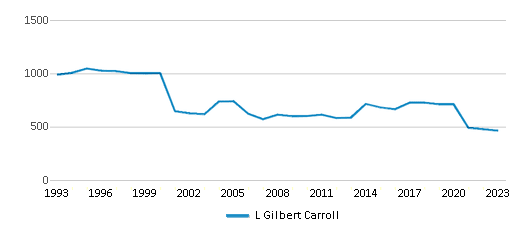
Gender %
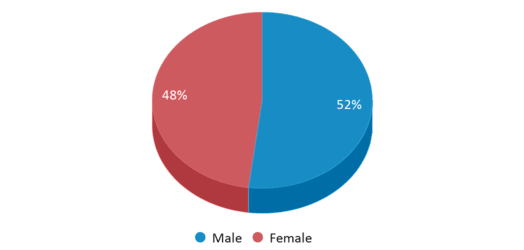
Total Classroom Teachers
23 teachers
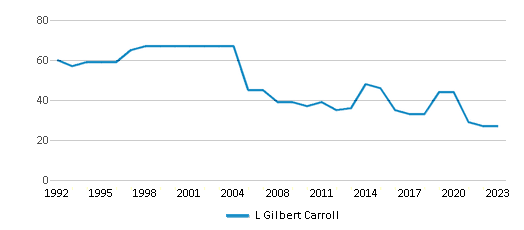
Students by Grade
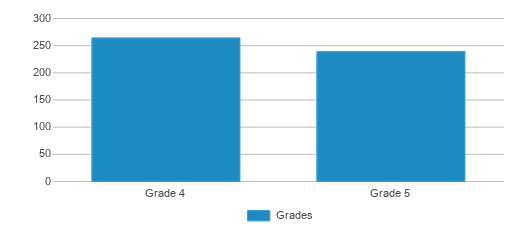
School Rankings
L Gilbert Carroll ranks within the bottom 50% of all 2,617 schools in North Carolina (based off of combined math and reading proficiency testing data).
The diversity score of L Gilbert Carroll is 0.72, which is more than the diversity score at state average of 0.71. The school's diversity has stayed relatively flat over five school years.
Overall Testing Rank
#2438 out of 2617 schools
(Bottom 50%)
(Bottom 50%)
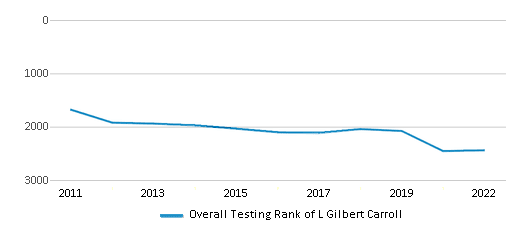
Math Test Scores (% Proficient)
19%
51%
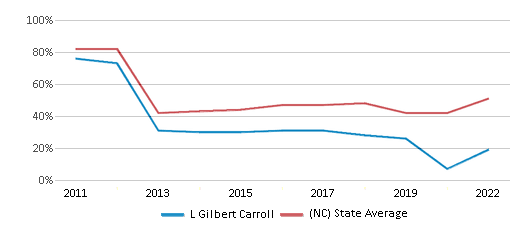
Reading/Language Arts Test Scores (% Proficient)
27%
50%
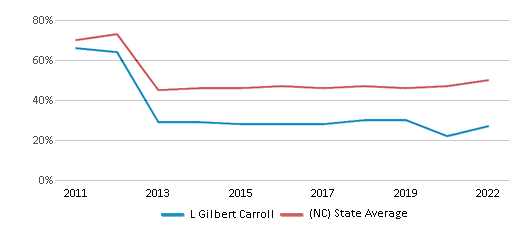
Science Test Scores (% Proficient)
39%
63%
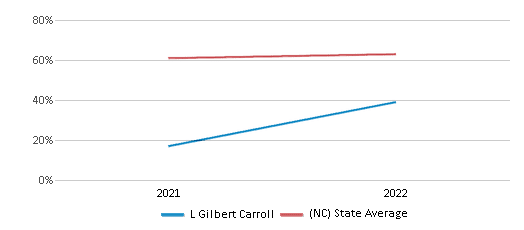
Student : Teacher Ratio
22:1
15:1
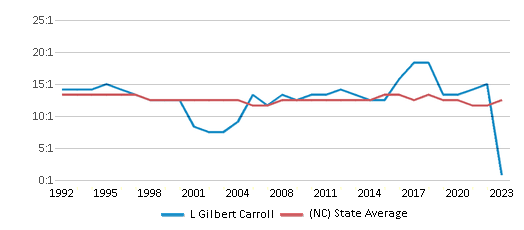
American Indian
12%
1%
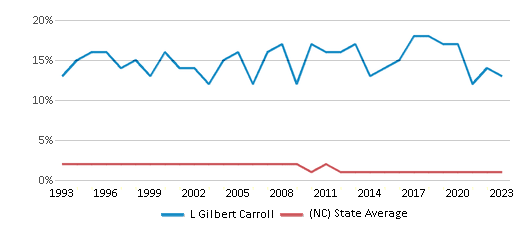
Asian
3%
4%
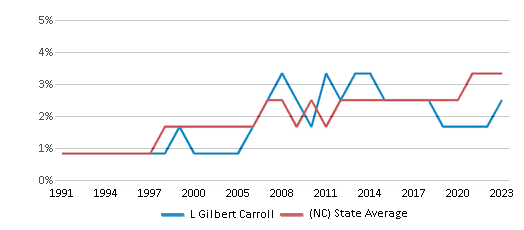
Hispanic
22%
21%

Black
46%
25%
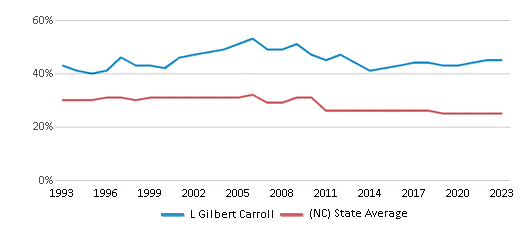
White
11%
43%
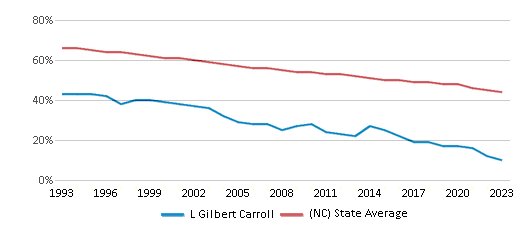
Hawaiian
n/a
n/a
Two or more races
6%
6%

All Ethnic Groups
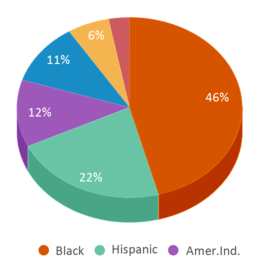
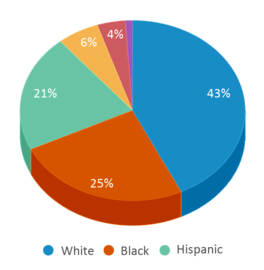
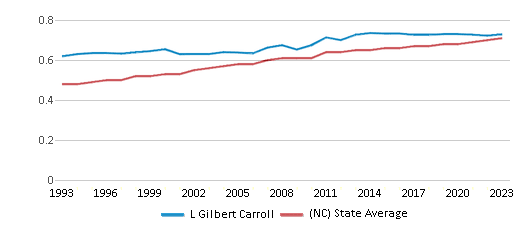
Participates in the National School Lunch Program (NSLP)
Yes
Eligible for Free Lunch
99%
68%

Eligible for Reduced Lunch (13-14)
4%
7%
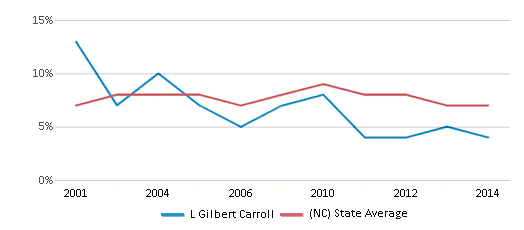
School Statewide Testing
School District Name
Source: National Center for Education Statistics (NCES), NC Dept. of Education
Profile last updated: 02/09/2025
Frequently Asked Questions
What is L Gilbert Carroll's ranking?
L Gilbert Carroll is ranked #2438 out of 2,617 schools, which ranks it among the bottom 50% of public schools in North Carolina.
What percent of students have achieved state testing proficiency in math and reading?
19% of students have achieved math proficiency (compared to the 51% NC state average), while 27% of students have achieved reading proficiency (compared to the 50% NC state average).
How many students attend L Gilbert Carroll?
503 students attend L Gilbert Carroll.
What is the racial composition of the student body?
46% of L Gilbert Carroll students are Black, 22% of students are Hispanic, 12% of students are American Indian, 11% of students are White, 6% of students are Two or more races, and 3% of students are Asian.
What is the student:teacher ratio of L Gilbert Carroll?
L Gilbert Carroll has a student ration of 22:1, which is higher than the North Carolina state average of 15:1.
What grades does L Gilbert Carroll offer ?
L Gilbert Carroll offers enrollment in grades 4-5
What school district is L Gilbert Carroll part of?
L Gilbert Carroll is part of Of Robeson County School District.
School Reviews
1 7/28/2021
I would not send a dog there due to the Administrator Mr. Chris Burton. He was hired from Whiteville Schools due to some issues with neglecting to give a student medical attention. If you Google this and fact check it''s in their newspaper and the parent's affidavit addressing the legal issues all made public(2016). As a parent, I am very concerned due to my child having severe medical issues. There is also a problem with discipline and to my understanding in the parent handbook, which is online, there is a school-wide behavior plan in place which is not followed or Mr. Burton refuses to implement with the teaching staff. He also has displayed behaviors that I as a parent I have witnessed that devastated me that private school was my next choice. Parent due to your research!!!!! HE IS A BULLY and has no common sense he definitely is not capable of dealing with the daily issues of children and it appears he is there for the paycheck and time credit for retirement. NOT LEARNING. NOT STUDENTS. It''s so easy to pass the problem to someone else so they can be the crash dummy. He really appears to be a Gym teacher who stands and looks hoping that a ball doesn''t hit him while asking What is of lunch today?Maybe someone above him will do something about this and check into the teacher turnover which seems to be the best indicator. Maybe not.
Review L Gilbert Carroll. Reviews should be a few sentences in length. Please include any comments on:
- Quality of academic programs, teachers, and facilities
- Availability of music, art, sports and other extracurricular activities
Recent Articles

Sexual Harassment at Age 6: The Tale of a First Grade Suspension
A six-year old in Aurora, Colorado, was suspended after singing an LMFAO song to a little girl in his class and reportedly “shaking his booty.” We look at the case and the sexual harassment problem in public schools today.

How Scaffolding Could Change the Way Your Child Learns
This article explores the concept of instructional scaffolding, a teaching method that enhances learning by breaking down complex tasks into manageable parts. It highlights how scaffolding supports students in developing critical thinking skills and becoming more independent learners. The article discusses the benefits of scaffolding, including improved engagement and reduced anxiety, and provides strategies for its implementation across various educational levels.

February 05, 2025
Understanding the U.S. Department of Education: Structure, Impact, and EvolutionWe explore how the Department of Education shapes American education, from its cabinet-level leadership to its impact on millions of students, written for general audiences seeking clarity on this vital institution.





